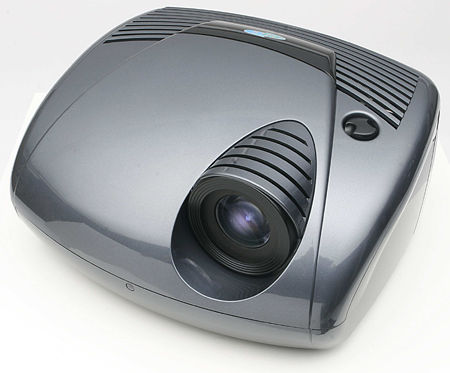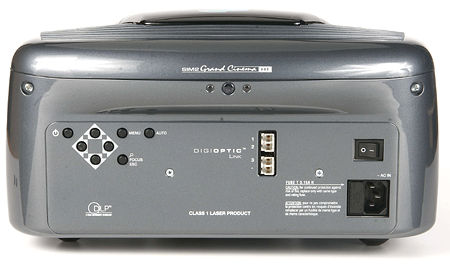SIM2 Grand Cinema HT 300 E-LINK DLP Projector
SIM City

The SIM2 Grand Cinema HT 300 E-LINK is to those early DLP projectors what anesthesia was to the bottle of whiskey and the leather belt that preceded it—mind-numbingly better and without all the hootin' and hollerin'. SIM2 uses a six-segment color wheel and TI's HD2+ chip (with DarkChip3 technology) to tame those rainbows. They're not completely gone—I still do see them occasionally. You may never see them, but I'm an overly sensitive guy, at least when it comes to my needs. In fact, most people don't seem to notice the rainbow effect at all, at least not without a little help. I love going to the big mega stores and pointing out the red, green, and blue spectral effect to DLP newbies. It's like giving Keanu Reeves the red pill.
The mirrors on the HD2+ rotate through a 12 degree deflection angle, a significant advance over earlier chips' 10 degree angle. This increased deflection angle directs the light from the projection lamp further away from the lens in the mirrors' off position, resulting in an improved contrast ratio—2800:1 or 3500:1, depending on whether or not you get your numbers from the user manual or SIM2's Web site. I get my numbers from our measurements (see the Testing and Calibration section), which I haven't seen as I write this.
The projector has a throw-distance ratio of 1.8:1 to 2.5:1. That means with my 78-inch-wide screen, I could position the projector anywhere from 140" (just under 11' 8") to 195" (16' 3"). I was at the very outer edge of that range in my setup.
A bit more throw would have put the flutter of the fan farther from my ears; alternatively, hanging the projector from the ceiling would make it a lot less audible. Still, once a movie gets started, you tend to lose track of the fan noise, even when it's close by. If I wasn't supporting an aging but beloved CRT projector, I'd go with a bigger screen. The HT 300 throws plenty of light on my Stewart Studiotek 130 in a darkened room.
A mechanical lens-shift control lets you position the HT 300 over a broad vertical range without resorting to digital keystone correction, an abomination that should always be avoided. Although the manual indicates the vertical throw range is symmetrical, I found it quite asymmetrical when tested at two heights, providing more displacement above the lens axis than below it. Practically speaking, this type of asymmetrical shift actually benefits normal ceiling or floor mount installations.
The HT 300 offers a very long lamp life. Rated at 8000 hours, the 120-watt lamp is the Energizer bunny of DLP lamps. I've seen some projectors whose lamps are rated to last as little as 1000 hours. Projector lamps are not inexpensive either. A new lamp for the SIM2 will run you $600 at current prices. That's a bit higher than with some projectors we've seen, but by no means the highest.
What a DOIP!
The HT 300 E-LINK projector actually uses a separate video-processing unit, which vastly simplifies system installation. The DigiOptic Image Processor, which also handles all the video switching, is connected to the projector with a very thin fiber-optic bundle. Each end of the bundle breaks out into three even thinner, numbered, optical connections. The cable can be very long—up to half a kilometer—without introducing attenuation problems. Practically speaking, you can run the cable through walls and ceilings without worrying that the long lengths could introduce signal degradation.

The back end of the DigiOptic Image Processor (DOIP) has oodles of inputs. If you're like me, you don't mind using your receiver or pre/pro as a video switcher for less-critical sources, like VCRs, standard-def DVRs, laserdiscs, and (if you have time for them) older video games. So SIM2 only puts two composite and two S-video inputs on the DOIP. That's plenty, and double the number you would find on most projectors that don't use a separate video-processing box.
On the other hand, I don't want to route my component or high-def signals through a receiver or processor, and you shouldn't either if you can avoid it. The straightest line is always, well, the straightest line. The HT 300 has four high-brow analog inputs, each of which can be configured to accept either component or RGB sources. One of them uses BNC connectors, but the remainder use five RCA jacks (only three of the connections are used with component sources). With RGB sources, the processor accommodates all forms of horizontal and vertical synchronization, including sync on green. One of the inputs (an RCA set) will only accept 480i (15.75 kHz) or 480p (31.5 kHz) scan rates, but the remainder will handle everything up to 1080i.
If your DVD player offers a progressive output, you'll have to make a decision: let your player handle the deinterlacing, or send an interlaced signal to the HT 300's processor and let it deinterlace the signal for you. There's a lot to recommend the latter option, like the velvety smooth Faroudja/Genesis DCDi chipset used by SIM2.
The best input paths for fixed-pixel displays are DVI or HDMI. The SIM2 has both, which is tremendously useful. I was able to use my Gefen 4x1 DVI switcher's output to feed the Samsung HD satellite receiver and Bravo D2 DVD player to the DOIP's DVI input while reserving the HDMI input for the Integra Research RDV-1.1 universal player. The RDV-1.1 and the Gefen didn't play nice together (more on that in the future), but removing the Gefen from the Integra's video path proved neither the player or nor the projector were at fault.
Two DB-15 connectors give your PC or modern game console access to the HT 300 E-LINK. I would never feed a game console to my CRT projector or plasma for fear of permanently burning in the image, but with DLP, you needn't worry. Be happy. You can feed anything up to a 1600x1200 image, though naturally, the DOIP will have its way until the image fits nicely into the 1280x720 space allotted. An RS-232 serial port is available for controlling the DOIP with a Lexicon or Crestron remote or home-automation system. I'm a remote junky. I like to surround myself with them, and I even keep a basket nearby for the ones I'm not using at the moment. Most people wouldn't want that, though, so the RS-232 is smart thinking.
























































